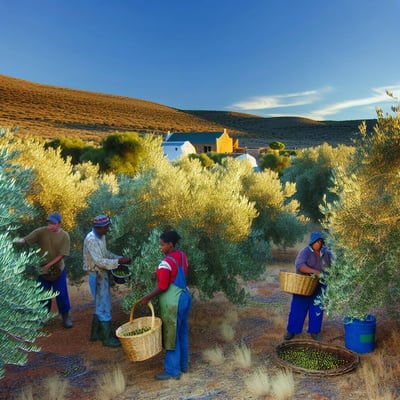Dive into the unique sensory experience of Misson olives, a hidden gem in the world of extra virgin...
Harvesting Process on the Boutique Olive Grove in the Karoo
Discover the traditional and sustainable methods used in the Jankovich boutique olive grove in the Karoo, where each olive is harvested with care and precision.
Click on the audio link above for instant listening gratification!

Exploring the Unique Olive Varieties of the Karoo
The Jankovich boutique olive grove in the Karoo is home to a variety of unique olive trees. These include Mission Olives, Frantoio Olives, Coratina Olives, and Leccino Olives. Each variety offers its own distinct flavor profile, making the olive grove a true haven for olive enthusiasts.
The Mission Olives are known for their rich and fruity taste, while the Frantoio Olives are prized for their peppery and robust flavor. The Coratina Olives offer a unique combination of bitterness and fruity notes, and the Leccino Olives are known for their mild and delicate taste.
Exploring the olive varieties at the Jankovich boutique olive grove in the Karoo is a delightful experience for anyone who appreciates the nuances of flavor that each type of olive brings to the table.
Organic Growing Practices in the Karoo's Olive Production
At the Jankovich boutique olive grove in the Karoo, the olive trees are grown in organic conditions. This means that no synthetic pesticides or fertilizers are used, ensuring a pure and natural product.
Organic growing practices are implemented to promote the health and vitality of the olive trees. This includes the use of organic compost and natural pest control methods. By prioritizing sustainability and environmental responsibility, the olive grove in the Karoo produces olives that are not only delicious but also organically produced.
Traditional Harvesting Techniques: Rakes and Matts
The harvesting process at the Jankovich boutique olive grove in the Karoo is carried out using traditional techniques involving rakes and matts. This method has been passed down through generations and ensures that each olive is carefully harvested by hand.
The first step in the harvesting process is to gently rake the olives off the branches using small handheld rakes. The olives fall onto large matts spread beneath the trees, preventing any damage to the fruit. The matts filled with freshly picked olives are then carefully lifted and emptied into crates. Each crate/s is weighed to determine the yield from each tree.
Using rakes and matts allows for a gentle and efficient harvest, ensuring that the olives remain intact and in pristine condition. This traditional approach highlights the growers' commitment to quality and craftsmanship.
Timing the Harvest: When and How Long it Takes
Timing is crucial when it comes to harvesting olives in the Karoo. The harvest usually takes place in autumn when the olives are at their peak ripeness. This is typically between April and May in the Karoo region.
The exact duration required to harvest a tree can vary depending on several factors, such as the size of the tree and the number of olives it bears. On average, it takes around 10 to 15 minutes to harvest a single tree.
The growers meticulously handpick each olive from the tree, ensuring that only the best quality olives are selected. This attention to detail and dedication to the harvesting process contribute to the exceptional quality of the olives produced at the Jankovich boutique olive grove.
From Tree to Table: The Step-by-Step Harvesting Journey
The journey of the olives from the tree to the table is a carefully orchestrated process at the Jankovich boutique olive grove in the Karoo.
1. Harvesting: The skilled harvesters use rakes to gently remove the olives from the branches. The olives fall onto matts, ensuring a soft landing and preventing any bruising or damage to the fruit.
2. Sorting and Cleaning: After the harvest, the olives are meticulously sorted to remove any leaves or debris. This ensures that only the highest quality olives are selected for further processing.
3. Pressing: The selected olives are then taken to the mill, where they are cold pressed to extract the precious olive oil. This process involves crushing the olives and separating the oil from the pulp.
4. Bottling: Once the olive oil is extracted, it is carefully bottled to preserve its freshness and flavor. The bottles are sealed and labeled, ready to be enjoyed by olive oil enthusiasts around the world.
The step-by-step harvesting journey guarantees that the olives are handled with utmost care and precision, resulting in a final product that is of exceptional quality and taste.
Join our mailing list by filling in the form below to get the latest news, recipes and product updates!